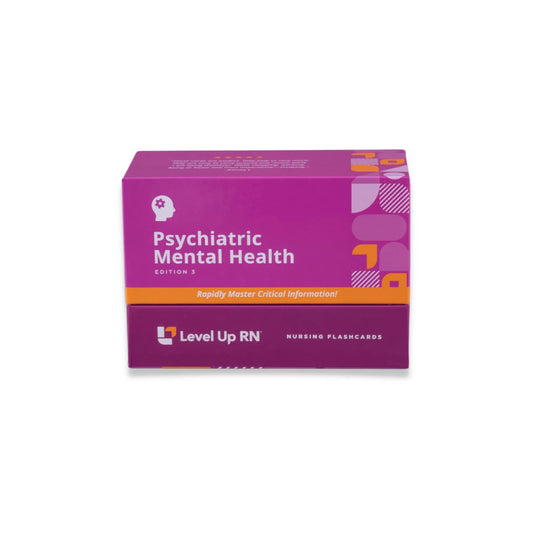This article covers cognitive behavioral therapy, or CBT, as well as eye movement desensitization and reprocessing (EMDR), and transcranial magnetic stimulation (TMS).
The Psychiatric Mental Health Nursing series follows along with our Psychiatric Mental Health Nursing Flashcards, which are intended to help RN and PN nursing students study for nursing school exams, including the ATI, HESI, and NCLEX.
Cognitive behavioral therapy (CBT)
Cognitive behavioral therapy (CBT) is a type of therapy that aims to modify the patient’s patterns of thinking and behavior.
Indications for someone who might benefit from CBT include depression, anxiety disorders, substance abuse, eating disorders, and personality disorders.
Psychiatric Mental Health - Nursing Flashcards
Emphasis of CBT
CBT aims to address and change an individual's negative distorted thinking ― negative automatic thoughts, underlying cognitive distortions, and underlying beliefs ― with more positive, rational thinking.
Automatic thoughts
Automatic thoughts are immediate, distorted thoughts a patient may have when interpreting events. For example, a nursing student who has a lot of anxiety around taking tests may say inside their head or out loud, “I am a terrible test taker.”
Cognitive distortions
Cognitive distortions are errors in logical thinking (e.g., fortune-telling, catastrophizing). Our example student would follow their negative automatic thought, “I’m a terrible test taker…” with a projection of the worst possible outcome, “...I’m going to fail this exam, and I’m going to get kicked out of my program.” This is catastrophizing.
Underlying beliefs
Underlying beliefs are core beliefs about the self and the world. For our example student, they might express a core belief (having catastrophized the outcome of their test-taking) such as, “I’m a failure.” Another common core (negative/underlying) belief people have is, “I am incapable of love.”
Goals of cognitive behavioral therapy
The goals of cognitive behavioral therapy (CBT) are to replace negative, distorted thoughts with positive, rational ones. This may include the use of thought recording (e.g., writing down and examining associations between situations, thoughts, and feelings).
For our nursing student, as they go to take their nursing exam, a more positive, rational type of thinking might include saying things like, “I’ve put in the hours and am putting my best foot forward. I am well-prepared, and I’m just going to do my best. And when that score comes in, I will deal with that at that time.”
Cognitive behavioral therapy may be used for a number of mental health disorders, including depression, anxiety, substance use disorder, eating disorders, and personality disorders.
What is dialectical behavioral therapy (DBT)?
Dialectical behavioral therapy, or DBT, is a specific type of cognitive behavioral therapy that is focused on improving self-regulation in patients as well as reducing self-destructive behavior. DBT is especially useful with personality disorders, particularly Borderline Personality Disorder.
Eye movement desensitization and reprocessing (EMDR)
Eye movement desensitization and reprocessing, or EMDR, is a therapy that is used to process traumatic memories that cause distress in the individual. It's particularly useful with PTSD and trauma-related disorders. EMDR is not recommended for patients who have seizures.
EMDR procedure
EMDR proceeds through an 8-phase approach, facilitated by a trained therapist. During a session of eye movement desensitization and reprocessing, the patient focuses on the memory of a traumatic event while engaging in eye movements or other bilateral stimulation (that is, stimulating both sides of the brain) to decrease the vividness and distress associated with the event.
Patient teaching for EMDR
Patients should expect EMDR to take from 6 to 12 sessions before therapeutic results are seen.
Transcranial magnetic stimulation (TMS)
Transcranial magnetic stimulation, or TMS, is a noninvasive procedure that uses a magnet to activate the area of the brain that is involved in mood regulation.
TMS procedure
TMS is indicated for treatment-resistant depression. During transcranial magnetic stimulation, a coil is held against the forehead, and electromagnetic pulses are administered, which activate the nerve cells in the brain.
Side effects of TMS
Side effects of TMS can include tingling, as well as contraction of the face or jaw muscles. A mild headache is possible as well.
Patient teaching for TMS
Treatment sessions for TMS last 30 to 60 minutes and do not require anesthesia as opposed to procedures and treatment options that are more invasive.


